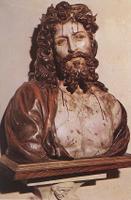A Picture of the Christ
 Q: It is the norm to portray Jesus as fair skinned and usually good looking by western standards. Isn’t it correct to think that Jesus most likely had dark skin similar to those who live in the Middle East today?
Q: It is the norm to portray Jesus as fair skinned and usually good looking by western standards. Isn’t it correct to think that Jesus most likely had dark skin similar to those who live in the Middle East today?More important, I have a recollection of a verse somewhere that while it doesn’t say Jesus was ugly it says something that indicates that there was nothing about His appearance that would cause us to be drawn to Him.
Can you tell me where the verse is and are there other verses that provide any information about His appearance?
A: Jesus being “blonde and blue” is a popular idea among northern Europeans and in some parts of Italy and elsewhere where such features are the norms. Most cultures who practice Christian religious art tend to make the Savior look somewhat like their own people. Yet, as you indicate, Jesus probably was darker featured than most Western art depicts Him. This is not only because of his Israelite human ancestry (and remember, some from Palestine are quite fair-skinned) but because He spent so much of his time outdoors in preaching and teaching and traveling from one place to another.
As a corresponding thought, He probably also was in better physical shape than most of our art shows him. The years of nonstop travel under often rugged conditions would have most likely resulted in a man who was lean but well-muscled, weathered and somewhat rugged looking.
 Isaiah 53:2-3 indicates that Messiah would not be particularly good looking by human standards: “For he grew up before him like a young plant, and like a root out of dry ground; he had no form or comeliness that we should look at him, and no beauty that we should desire him. He was despised and rejected by men; a man of sorrows, and acquainted with grief; and as one from whom men hide their faces he was despised, and we esteemed him not.”
Isaiah 53:2-3 indicates that Messiah would not be particularly good looking by human standards: “For he grew up before him like a young plant, and like a root out of dry ground; he had no form or comeliness that we should look at him, and no beauty that we should desire him. He was despised and rejected by men; a man of sorrows, and acquainted with grief; and as one from whom men hide their faces he was despised, and we esteemed him not.”When we look back earlier in this passage of the Suffering Servant, we get the idea that while He may have begun as an “ordinary Joe” in appearance, His natural features did not cause men to “hide their faces” from Him. Any physical ugliness came through his torture, for, “he was wounded for our transgressions; he was crushed for our iniquities; upon him was the chastisement that brought us peace, and with his stripes we are healed. (Isaiah 53:5)”
An even greater — a spiritual — ugliness also clung to Him: In Jesus, the Father saw all the grotesqueries of our sins, since God “made him to be sin who knew no sin, so that in him we might become the righteousness of God. (2 Corinthians 5:21)”
Isaiah summed up Christ’s entire life, suffering, death, resurrection, ascension, preaching of His Gospel, and return in glory in chapter 52:13-15: “Behold, my servant shall act wisely; he shall be high and lifted up, and shall be exalted. As many were astonished at you — his appearance was so marred, beyond human semblance, and his form beyond that of the children of mankind — so shall he sprinkle many nations; kings shall shut their mouths because of him; for that which has not been told them they see, and that which they have not heard they understand.”
All of chapter 53 then expounds upon these verses, both as the Servant is punished for our sins and as He is raised in glory because of his faithfully carrying out the will of the Lord. Amazingly, we have more of a physical description of Jesus from Isaiah, who lived around seven hundred years before the Christ was born, than we do from all the books of the New Testament, including the four Gospels.
Scripture quoted from The Holy Bible, English Standard Version™, © 2001 by Crossway Bibles.
Send email to Ask the Pastor.
Walter Snyder is the pastor of Holy Cross Lutheran Church, Emma, Missouri and coauthor of the book What Do Lutherans Believe.

0 Comments:
Post a Comment
<< Home